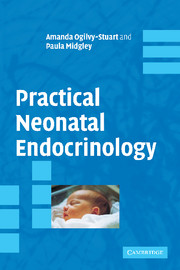Book contents
- Frontmatter
- Contents
- Acknowledgements
- Introduction
- 1 Hyperglycaemia
- 2 Hypoglycaemia
- 3 Management of hyperinsulinism
- 4 Hypoglycaemia in infant of a diabetic mother
- 5 Dysmorphic features
- 6 Micropenis
- 7 Hypopituitarism
- 8 Ambiguous genitalia (male): XY disorders of sex development
- 9 Cryptorchidism
- 10 Ambiguous genitalia (female): XX disorders of sex development
- 11 Pigmented scrotum
- 12 Adrenal failure
- 13 Collapse
- 14 Hypotension
- 15 Hyponatraemia
- 16 Hyperkalaemia
- 17 Hypernatraemia
- 18 Maternal steroid excess
- 19 Hypercalcaemia
- 20 Hypocalcaemia
- 21 Investigation and management of babies of mothers with thyroid disease
- 22 Maternal or familial thyroid disease
- 23 Goitre
- 24 Abnormal neonatal thyroid function tests
- 25 Hypothyroxinaemia in preterm infants
- Appendix 1 Calculation of glucose infusion rate
- Appendix 2 Dynamic tests
- Appendix 3 Normal ranges
- Appendix 4 Biochemistry samples
- Appendix 5 Formulary
- Index
5 - Dysmorphic features
Published online by Cambridge University Press: 15 February 2010
- Frontmatter
- Contents
- Acknowledgements
- Introduction
- 1 Hyperglycaemia
- 2 Hypoglycaemia
- 3 Management of hyperinsulinism
- 4 Hypoglycaemia in infant of a diabetic mother
- 5 Dysmorphic features
- 6 Micropenis
- 7 Hypopituitarism
- 8 Ambiguous genitalia (male): XY disorders of sex development
- 9 Cryptorchidism
- 10 Ambiguous genitalia (female): XX disorders of sex development
- 11 Pigmented scrotum
- 12 Adrenal failure
- 13 Collapse
- 14 Hypotension
- 15 Hyponatraemia
- 16 Hyperkalaemia
- 17 Hypernatraemia
- 18 Maternal steroid excess
- 19 Hypercalcaemia
- 20 Hypocalcaemia
- 21 Investigation and management of babies of mothers with thyroid disease
- 22 Maternal or familial thyroid disease
- 23 Goitre
- 24 Abnormal neonatal thyroid function tests
- 25 Hypothyroxinaemia in preterm infants
- Appendix 1 Calculation of glucose infusion rate
- Appendix 2 Dynamic tests
- Appendix 3 Normal ranges
- Appendix 4 Biochemistry samples
- Appendix 5 Formulary
- Index
Summary
Clinical presentation
Dysmorphic features may point to an underlying endocrine abnormality.
Approach to the problem
Examination for
Midline defects, e.g. central cleft palate and/or lip, hypotelorism or hypertelorism.
Features of recognizable syndrome, e.g. Beckwith–Wiedemann syndrome (macroglossia, ear lobe creases, exomphalos), Smith–Lemli–Opitz (microcephaly, second- and third-toe syndactyly, see below), Robinow syndrome.
Other physical features to look for
Symmetrical growth retardation.
Micropenis (hypopituitarism, dysmorphic syndrome, see below).
Large-for-gestational-age, exomphalos, ear lobe creases (Beckwith–Wiedemann syndrome).
Other symptoms/signs
Hypoglycaemia (hormone insufficiency: e.g. cortisol, growth hormone (GH); hormone excess: i.e. insulin; metabolic abnormality).
Hypothermia (hypopituitarism; sepsis, which can be secondary to an underlying metabolic problem).
Prolonged jaundice (hypopituitarism).
Tetany or seizures (hypocalcaemia).
History of
Consanguinity suggestive of an autosomal recessive problem.
Neonatal death suggestive of inherited disorder, e.g. metabolic disorder previously presenting as Escherichia coli septicaemia.
Facial appearance of parents (i.e. facial features may be normal for the family).
Differential diagnosis
Underlying genetic defect
Hypopituitarism with or without septo-optic dysplasia (SOD), optic nerve hypoplasia (ONH)
Hypoadrenalism
Hypocalcaemia (hypoparathyroidism, e.g. DiGeorge syndrome)
Metabolic disorder
Identify those with implication for:
urgent management (Beckwith–Wiedemann, SOD, inborn errors of metabolism);
hormone balance in the newborn period (infants with Down's syndrome have an increased incidence of hypothyroidism).
Always consider hypopituitarism in the infant with undermasculinized genitalia, particularly when associated with hypoglycaemia and/or hypotension.
- Type
- Chapter
- Information
- Practical Neonatal Endocrinology , pp. 31 - 40Publisher: Cambridge University PressPrint publication year: 2006



